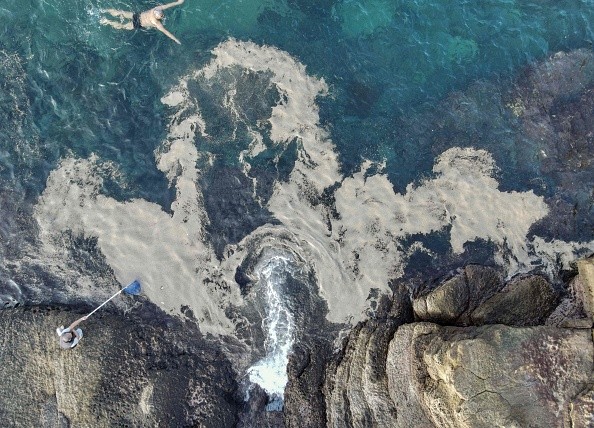Natural oil seeping onto the Santa Barbara Channel is a beachgoer's nightmare, flecking the shores with blobs of tar.
However, the leaking petroleum created intriguing geologic and biological features.
Several jet-black mounds interrupted the featureless sea floor about 10 miles off the coast of Santa Barbara.
Asphalt volcano communities
 (Photo : SAM YEH/AFP via Getty Images)
(Photo : SAM YEH/AFP via Getty Images)

The first detailed description of the animal communities that live in these formations has been compiled by marine scientists, as per ScienceDaily.
The findings, published in the Marine Science Bulletin, described the various types of fish that live on and around volcanoes.
Asphalt volcanoes were first discovered in the Gulf of Mexico by scientists.
These vents erupt hot tar rather than lava, gradually forming smooth mounds several dozen feet tall.
A team led by UC Santa Barbara Professor Dave Valentine documented two volcanoes in the Santa Barbara Channel in 2010, naming them Il Duomo and Il Duomito; the taller of the two, Il Duomo, stands about 65 feet tall.
The group described the geology and characterized the habitat.
Only one other site has been discovered off the coast of Angola since then.
Even in channels, which has a lot of seeps, we only know of two asphalt volcanoes, according to lead author Milton Love, a researcher at UC Santa Barbara's Marine Science Institute.
As a result, it takes a nearly unique set of circumstances to form these.
Despite this, little was known about the animals that lived at asphalt volcanoes other than a brief description provided by Valentine and his co-authors in their 2010 paper.
As a result, Love and his colleagues used footage from an autonomous underwater vehicle to characterize the fish communities that live in these amazing features.
The team sifted through eight hours of surveys, resulting in 2,743 still images, gradually compiling a roster of the neighborhood.
Despite low fish densities, the team discovered a relatively diverse assemblage of species.
They observed 1,836 fish from 43 different species in total, and rockfish accounted for at least 53.5% of these species.
"This is what you'd expect to find if you surveyed a tall and relatively smooth rock reef in this location," Love explained.
Certain fish, such as the swordspine, greenblotched, and greenspotted rockfish, preferred the volcanoes' uniform slopes.
Meanwhile, the muddy sea bottom surrounding the mounds was populated by a variety of poachers and flatfishes.
Surprisingly, there were haloes several meters wide around the volcanoes that were devoid of flatfishes.
Love believed that any fish that got too close were spotted against the black tar and eaten.
A green-blotched rockfish looms in the shadows, alongside a sea star, a basket star, and a deep-sea anemone, all of which have made their homes on the slopes of one of the channel's asphalt volcanoes.
Shortspine combfish, green-striped rockfish, and spotted ratfish were among the taxa observed moving between the mud and the asphalt's edges.
The "sheltering guild" of fishes, such as bocaccio and cowcod, require nooks and crannies that are lacking on the smooth slopes of the asphalt volcanoes, as well as the surrounding sea floor.
The authors wrote that even small amounts of asphalt in an image had a significant effect on the species observed, as soft-seafloor fishes avoided the hard tar.
The animals that call volcanoes home
Ol Donyo Lengai in Tanzania is one of Africa's most active volcanoes, with Lake Natron on its northern flank, as per the BBC Earth.
This is one of the world's most toxic bodies of water, but it also serves as a gathering and breeding ground for two million lesser flamingos.
Lake Natron's water temperature frequently exceeds 40°C and is extremely alkaline due to the sodium carbonate and other minerals that flow into the lake from the surrounding hills.
These conditions can cause the skin to burn, rendering it inhospitable to most plants, animals, and humans.
The flamingos' tough skin and scales on their legs protect them from burns, and they have the unusual ability to drink water near boiling temperature and remove salt from water using their nasal cavity.
The lesser flamingo has made this infernal place their paradise by utilizing these unique characteristics.
The flamingos build their nests on small islands that form in the lake during the dry season, away from most predators.
And because there is little competition for food, the flamingos have easy access to algae, which is a vital source of food in volcanic water.
Fernandina Island is the most active and pristine of the Galapagos volcanoes, and it is home to some of the Archipelago's most iconic and endangered species, such as marine and land iguanas, flightless cormorants, penguins, and sea lions, all of which have adapted and lived in this remote territory.
Female land iguanas have taken advantage of the volcano's thermal heat.
Every year, nearly 2,000 of these lizards make the ten-day journey from the coast to the summit of La Cumbre, where they descend the crater's steep slopes.
When they reach the bottom, they lay their eggs in the soft, warm ash, which is ideal for incubation.
Related article: Mauna Loa, Hawaii's Biggest Volcano, is Currently in an Active Phase
© 2024 NatureWorldNews.com All rights reserved. Do not reproduce without permission.

![Climate Change is Reducing Dust Levels Worldwide as Arctic Temperature Warms [Study]](https://1471793142.rsc.cdn77.org/data/thumbs/full/70320/280/157/50/40/climate-change-is-reducing-dust-levels-worldwide-as-arctic-temperature-warms-study.jpg)
![Tsunami Hazard Zones: New US Map Shows Places at Risk of Flooding and Tsunamis Amid Rising Sea Levels [NOAA]](https://1471793142.rsc.cdn77.org/data/thumbs/full/70325/280/157/50/40/tsunami-hazard-zones-new-us-map-shows-places-at-risk-of-flooding-and-tsunamis-amid-rising-sea-levels-noaa.jpg)


